Ilfracombe branch line
The Ilfracombe branch of the London & South Western Railway (LSWR), ran between Barnstaple and Ilfracombe in North Devon. The branch opened as a single-track line in 1874, but was sufficiently popular that it needed to be upgraded to double-track in 1889.
| Ilfracombe branch line | |||||||||||||||||||||||||||||||||||||||||||||||||||||||||||||||||||||||||||||||||||||||||||||||||||||||||||||||||||||||||||||||||||||||||||||||||||||
|---|---|---|---|---|---|---|---|---|---|---|---|---|---|---|---|---|---|---|---|---|---|---|---|---|---|---|---|---|---|---|---|---|---|---|---|---|---|---|---|---|---|---|---|---|---|---|---|---|---|---|---|---|---|---|---|---|---|---|---|---|---|---|---|---|---|---|---|---|---|---|---|---|---|---|---|---|---|---|---|---|---|---|---|---|---|---|---|---|---|---|---|---|---|---|---|---|---|---|---|---|---|---|---|---|---|---|---|---|---|---|---|---|---|---|---|---|---|---|---|---|---|---|---|---|---|---|---|---|---|---|---|---|---|---|---|---|---|---|---|---|---|---|---|---|---|---|---|---|---|
| Overview | |||||||||||||||||||||||||||||||||||||||||||||||||||||||||||||||||||||||||||||||||||||||||||||||||||||||||||||||||||||||||||||||||||||||||||||||||||||
| Status | closed, parts converted to bicycle paths | ||||||||||||||||||||||||||||||||||||||||||||||||||||||||||||||||||||||||||||||||||||||||||||||||||||||||||||||||||||||||||||||||||||||||||||||||||||
| Locale | North Devon, England | ||||||||||||||||||||||||||||||||||||||||||||||||||||||||||||||||||||||||||||||||||||||||||||||||||||||||||||||||||||||||||||||||||||||||||||||||||||
| Termini | Barnstaple Junction Ilfracombe | ||||||||||||||||||||||||||||||||||||||||||||||||||||||||||||||||||||||||||||||||||||||||||||||||||||||||||||||||||||||||||||||||||||||||||||||||||||
| Stations | 7 | ||||||||||||||||||||||||||||||||||||||||||||||||||||||||||||||||||||||||||||||||||||||||||||||||||||||||||||||||||||||||||||||||||||||||||||||||||||
| Service | |||||||||||||||||||||||||||||||||||||||||||||||||||||||||||||||||||||||||||||||||||||||||||||||||||||||||||||||||||||||||||||||||||||||||||||||||||||
| Type | branch line | ||||||||||||||||||||||||||||||||||||||||||||||||||||||||||||||||||||||||||||||||||||||||||||||||||||||||||||||||||||||||||||||||||||||||||||||||||||
| System | London & South Western Railway | ||||||||||||||||||||||||||||||||||||||||||||||||||||||||||||||||||||||||||||||||||||||||||||||||||||||||||||||||||||||||||||||||||||||||||||||||||||
| History | |||||||||||||||||||||||||||||||||||||||||||||||||||||||||||||||||||||||||||||||||||||||||||||||||||||||||||||||||||||||||||||||||||||||||||||||||||||
| Opened | 20 July 1874 | ||||||||||||||||||||||||||||||||||||||||||||||||||||||||||||||||||||||||||||||||||||||||||||||||||||||||||||||||||||||||||||||||||||||||||||||||||||
| Closed | 5 October 1970 | ||||||||||||||||||||||||||||||||||||||||||||||||||||||||||||||||||||||||||||||||||||||||||||||||||||||||||||||||||||||||||||||||||||||||||||||||||||
| |||||||||||||||||||||||||||||||||||||||||||||||||||||||||||||||||||||||||||||||||||||||||||||||||||||||||||||||||||||||||||||||||||||||||||||||||||||
The 1–in–36 gradient between Ilfracombe and Mortehoe stations was one of the steepest sections of double track railway line in the country, and was most certainly the fiercest climb from any terminus station in the UK. In the days of steam traction, it was often necessary to double-head departing passenger trains.
'Named' trains such as the Atlantic Coast Express and the Devon Belle both started and terminated at Ilfracombe.
Despite nearly a century of bringing much-needed revenue into this remote corner of the county, passenger numbers dropped dramatically in the years following the Second World War due to a massive increase in the number of cars on Britain's roads, and the line finally closed in 1970.
Much of the course of the line is still visible today, and sections of it have been converted into public cycleways.
A group has been set up to create a heritage railway on the line.
History
On 20 July 1874 a railway link was opened between Barnstaple and Ilfracombe.[1] The line was originally laid as a single-track light railway, which restricted the type of trains that could use it. Popularity led to expansion, and much of the line was converted to double track between 1889 and 1891. This was a major exercise, requiring the rebuilding of most of the stations, and cutting a second bore for the Slade tunnel.
The Southern Railway era started with the Railways Act 1921 and the grouping of the railways. This took effect on 1 January 1923, when the LSWR was absorbed into the new Southern Railway along with its southerly neighbour, the London, Brighton and South Coast Railway and the South Eastern and Chatham Railway. The GWR formed a group of its own (combining with a large number of smaller lines). Competition to the south, to Portsmouth and Epsom ceased, but critically, competition in the West with the GWR was unaffected.[2][4]
Amongst the ordinary services, the Southern Railway also operated famous titled express trains such as the Atlantic Coast Express ("ACE"). With a large variety of holiday destinations including Bude, Exmouth, Ilfracombe, Padstow, Plymouth, Seaton, Sidmouth and Torrington, the 11am "ACE" from Waterloo, as the Atlantic Coast Express became known, was the most multi-portioned train in the UK from its introduction in 1926. This was due to sections of the train splitting at selected junctions for onward journey to their final destinations in the West Country. Padstow railway station in Cornwall was the westernmost point of the Southern Railway, and marked the end or beginning of the "ACE", which was the longest timetabled journey on the network.
The line was mentioned as a candidate for closure in the Reshaping of British Railways report (the Beeching cuts), in 1963, but it was not closed by British Railways until 1970. Steam-hauled passenger services and freight operations ceased on 7 September 1964 (with one special running on 3 October 1965), and the rationalisation of the line began. DMU services began, the Waterloo through services were stopped, and the line was down-graded to single track on 25 November 1967.
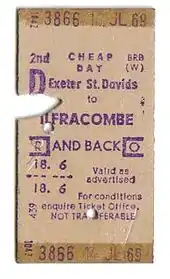
It was in May 1967 that the Network for Development Plans were issued by Barbara Castle, the then Labour Minister of Transport, following a study. Where lines were at the remunerative end of the scale, such as the main trunk routes and some secondary lines, these would be developed. But those that failed to meet the financial criterion, but served a social need were to be retained and subsidised under the Transport Act 1968. The problem would be for lines that were not in the above-mentioned categories, which could be candidates for closure as they did not form part of the basic railway network. The Ilfracombe line was one of those that fell into this category. It was a line that may well have carried considerable traffic, and perhaps made a small profit, but it did not meet the government's social, economic and commercial criteria for retention.
The line was closed on 5 October 1970, the last train being on 3 October. The final train, an 8-car Class 118 DMU, was packed to bursting point. There was an abortive attempt at saving the line in the early 1970s, but the preservation movement was in its infancy and the project was to flounder as it could not raise the required sum to purchase the line outright. This was because BR had valued the line at £410,000 in 1974 and BR was criticised for charging market values for a potential heritage railway that wanted to preserve it. It must be appreciated that the BR board was under instruction from the ministry to fix the highest price possible in an attempt to recoup funds to offset the deficit that the line produced. The last train was formed of a single inspection saloon hauled by a Class 25, 25 063, on Wednesday 26 February 1975. This carried engineers inspecting the condition of the track for possible reinstatement of services. However this was not to be and track lifting commenced in June 1975.
The distinctive curved steel girder bridge over the River Taw in Barnstaple was demolished in 1977, adding a significant cost to any future reopening scheme.
Stations
Barnstaple Junction

The tracks entering from the left mark the southern end of the Ilfracombe branch; those in the foreground lead to Bideford.
- Simply named Barnstaple before the building of the Ilfracombe branch.
Connections to:
- LSWR Route to Exeter (still active as The Tarka Line)
- GWR Barnstaple to Taunton railway
- LSWR route to Bideford, Great Torrington and beyond
Barnstaple Quay
- The original station to the north of the bridge
- Renamed Barnstaple Town in 1886
- Closed in the same year, when the larger new Barnstaple Town opened, to cope with the Lynton and Barnstaple Railway.
Barnstaple Town
- 250yards west of the site of Barnstaple Quay
- Moved to the wider site to allow provision of a second platform
- Connection for the Lynton & Barnstaple Railway
- See station article for more pictures
Wrafton
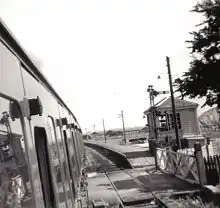
- The smallest station on the line
- Served the village of Wrafton and the aerodrome of RAF Chivenor
- Two platforms and two goods sidings, one for the RAF base
- Two camping coaches were positioned here by the Southern Region from 1954 to 1964, including two Pullman camping coaches in 1961 and 1962.[5]
- Station building is now a private house
Braunton
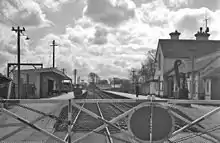
- Served the village of Braunton
- Station building now used as a newsagent
- Goods shed was converted for use as a local youth club, now (2018) the surfing museum.
 Braunton station 4 May 1969
Braunton station 4 May 1969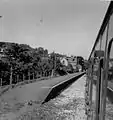 Braunton in July 1969
Braunton in July 1969 Braunton Station - 1977
Braunton Station - 1977
Mortehoe & Woolacombe
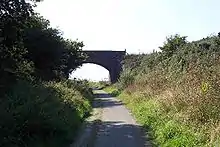
Mortehoe & Woolacombe station, originally named just Mortehoe, was over a mile away from either Woolacombe or Mortehoe, the villages being reached by steep twisty roads from the station. It was also the nearest station for Lee Bay, although the route to that village was even more steep and twisty.
The bridge at the north end of the station was the summit of the line.
Several sidings were provided for the stabling of banking locomotives, vital for assisting trains up the steep gradients to the station from Ilfracombe (1-in-36) or Braunton (1-in-40).
Until about 2008, the station was still largely intact. The main station building, signal box and platforms were still extant, and some of the original concrete lampposts still in place. Since then, the site has been sold and partially redeveloped for housing, although the original station building and signal box have been incorporated in the structures.
'Once Upon a Time'

For a number of years the station was the site of a young children's theme park called Once Upon a Time, which was operated by the owners of Watermouth Castle.
The station site is in a prominent position on the main road leading to Woolacombe. From outside the site could be seen four (BR Mk 1) carriages (retired from the Dart Valley Railway) sited between the platforms, while scattered around the grounds were a number of '12 ton' van bodies used for storage or housing attractions. (Several of these were of the BR type 'VANWIDE', their double sliding doors being particularly useful for the purpose.)
The business closed at the end of the 2005 season. The site was sold in 2006, and was earmarked for re-development as affordable rural housing. By August 2007, all of the external amusement rides and constructions had been auctioned off or demolished, leaving just the main buildings and platforms intact.
Ilfracombe
- The terminus included an engine shed, turntable, goods yard and many sidings to cope with stabling the lengthy passenger trains used on summer Saturdays.
- The site is now the location of the Pall Europe factory.
Runs up past Mullacott past the two Slade reservoirs.
Gallery
Ilfracombe station on 14 July 1969
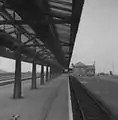 Platforms 1 & 2.
Platforms 1 & 2.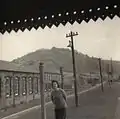 Station sign and goods shed.
Station sign and goods shed. The carriage sidings.
The carriage sidings.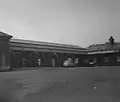 The station buildings from the road entrance
The station buildings from the road entrance The track layout looking towards Barnstaple
The track layout looking towards Barnstaple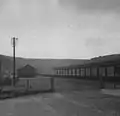 The goods yard and shed from the car park
The goods yard and shed from the car park The station approach
The station approach Running down into Ilfracombe
Running down into Ilfracombe
Mortehoe Bank
The most notable feature of the line were the steep climbs, from both directions to the summit at Mortehoe station. Other lines had steep banks too. The now closed Folkestone Harbour branch was at 1 in 30. The famous Lickey Incline, between Bromsgrove and Blackwell on the Gloucester to Birmingham line, is now the steepest sustained adhesion-worked gradient on British railways, with a northbound climb of 1 in 37¾ for two miles. In steam days, all except the lightest trains required the services of a banker; however, since dieselisation, this is no longer necessary, except for certain freight services.
Rather nearer are the Dainton Banks – a 4-mile stretch of the GWR main line between Newton Abbot and Totnes. This section was designed for atmospheric propulsion, rather than steam haulage, and consequently has curves and gradients that would not be dreamed of for a loco-hauled line. The westbound ascent to Dainton Tunnel includes gradients between 1 in 57 and 1 in 36 over a two-mile stretch. Eastbound is slightly easier, comprising, in the space of one mile, gradients of 1 in 55 to 1 in 37.
Nevertheless, The Mortehoe banks were much harsher. Northbound there was a 3½ mile continuous climb of 1 in 41, from Heddon Mill Crossing to Mortehoe. While southbound, from Ilfracombe to Mortehoe, the climb was 1 in 36 for 2½ miles, with severe S-curves past Lower Slade making the journey even harder. Banking engines were kept at Braunton and Ilfracombe, to assist when required. Mortehoe station provided a number of sidings for stabling the banking engines after assisting with the climb.
Locomotives
The severe gradients and sharp curves of the line always limited choice to the smallest engines in the fleet.
The original motive power was provided by a class of small 0-6-0 tender locos that later became known as the Ilfracombe Goods (see below).
LSWR "Jubilee" Class A12 0-4-2s replaced the Ilfracombe Goods engines on passenger work, and were themselves replaced by the T1 Class 0-4-4Ts around the turn of the century. From about 1914, LSWR Class M7 0-4-4Ts were commonly used.
After the Grouping, the Southern Railway introduced the new Maunsell N class 2-6-0s, in 1925. These were used for services to Exeter and beyond until the arrival of the 'light pacifics' in 1945.
The Bulleid SR West Country and Battle of Britain classes of 'Light Pacific' were the largest engines to visit Ilfracombe, and were the preferred choice for the Waterloo services and the Devon Belle. In later years, despite the removal of their 'air-smoothed' boiler casings, the rebuilt examples of these engines would not have been seen, as they were too heavy to use the line.
As may be inferred from the name, the West Country locos were named after places in south-west England to which the Southern Railway ran. Enthusiasts always delighted in trying to take pictures of these engines at their 'home town'; and they had many opportunities on the Ilfracombe branch, since there were locos named: Woolacombe, Mortehoe, Barnstaple, Ilfracombe and Braunton.
Following Nationalisation, many more through trains were timetabled from Taunton, leading to an increase in the number of ex-GWR locos that visited the branch. Ideally suited to the work were the 43xx class 'Moguls' (2-6-0 tender locos) and the 2251 class 'Colletts' (0-6-0 tender locos).
In September 1964, all steam haulage was withdrawn from the line, and most services were thereafter provided by diesel multiple units. However, some long-distance trains still operated, and these were usually loco-hauled. In later years many different diesel-hydraulic classes appeared on the line, including Baby Warships, Hymeks, and Warships. A pair of Class 33 (Cromptons) were also noted on the line, including 33 048 (now preserved on the West Somerset Railway), on 30 August 1970 with the West Sussex Railway Touring Trust 'Chartex Special'. The last train was hauled by a Class 25: 25 063 on Wednesday, 26 February 1975.
The "Ilfracombe Goods" locomotives
In 1873, three locomotives were ordered by William George Beattie – locomotive engineer for the London and South Western Railway – for the opening of the Ilfracombe line in its original, lightly-laid form. The LSWR 282 class was an 0-6-0 mixed traffic tender locomotive designed and built by Beyer Peacock. They were sufficiently useful that the order was extended to five locomotives in 1874, with a sixth for the Sidmouth Railway in 1875. Two further locomotives were built in 1880, bringing the class total to eight.
When the branch lines for which they were originally designed were upgraded in the 1890s, there was no suitable work for the locomotives so all members of the class were moved away to London and Bournemouth. Two locomotives were scrapped in 1905, but the remainder were sold to various railways operated by Colonel Stephens, and continued in use into the 1930s, the last being scrapped in 1939.
Also see Locomotives of the Southern Railway.
Services
The 'N'-class locomotives were limited to fifteen loaded wagons over the Mortehoe bank, however if there were more than eleven trucks, the train was required to have two manned brake vans.
A year after the end of regular steam operations, the Southern Counties Touring Society ran the "Exeter Flyer", a special train on 3 October 1965 (hauled by BR Standard Class 4MT 2-6-4T no 80043).
The introduction of a full DMU service in September 1964 resulted in through workings from Exmouth, Sidmouth, Honiton and Salisbury, but direct Waterloo services were discontinued.
Walking the line today
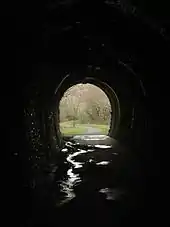

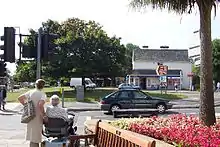
The trackbed between Mortehoe Station and Ilfracombe has been restored as the Devon Coast to Coast Cycle Route (rail trail) and forms part of the Tarka Trail. It is possible to walk or cycle from the north road bridge parapet by Woolacombe & Mortehoe Station, down the long descent towards Ilfracombe, passing the Slade reservoirs and going through one of the twin-bore tunnels south of Ilfracombe station.
The former line is surrounded by The Cairn – heathland planted with trees during the 1960s and transformed into a Local Nature Reserve.
South of Woolacombe, it is easy to follow the course of the line by car, as the trackbed closely follows the A361 road for much of the route between Barnstaple and Mullacott Cross (just outside Woolacombe/Ilfracombe).
Ilfracombe Museum contains many photographs and relics from the line, including a gradient post and one of the concrete station name boards from Ilfracombe Station (both visible outside the building).
Preservation
Members of a group on the social networking site Facebook entitled "Reversing Beeching - the Ilfracombe Line" first mooted the idea of forming a real-world preservation society. On 22 March 2015 members of the group held their first meeting and agreed to apply for charity status to help forward the project's aims.[6] The Combe Rail group on Facebook was launched the following day and a website followed soon afterwards. On 23 October 2015 Combe Rail obtained Registered Charity status[7] with the intention of establishing a heritage railway on the trackbed of the Ilfracombe-Barnstaple line as well as lobbying for a full reopening in the future.[8]
In January 2019, Campaign for Better Transport released a report identifying the line was listed as Priority 2 for reopening. Priority 2 is for those lines which require further development or a change in circumstances (such as housing developments).[9]
See also
- Southern Railway routes west of Salisbury
- Other local railway attractions:
References
- Anon (18 July 1878). "Calendar for the Week". The Cornishman (Volume 1, Number 1). p. 8.
- C F Dendy Marshall, History of the Southern Railway, Ian Allan, Shepperton, 1982 reprint (revised by Kidner), ISBN 0 7110 0059 X
- Peter Semmens, Great Western Railway -- 1: Consolidation 1923 - 1929, George Allen and Unwin, London, 1985, ISBN 0-04-385104-5
- McRae, Andrew (1998). British Railways Camping Coach Holidays: A Tour of Britain in the 1950s and 1960s. Scenes from the Past: 30 (Part Two). Foxline. p. 59. ISBN 1-870119-53-3.
- "Ilfracombe railway link with Barnstaple could return thanks to Combe Rail project - North Devon Journal". Archived from the original on 11 August 2015. Retrieved 12 January 2016.
- "Charity framework". Retrieved 12 January 2016.
- "Bid to set up Ilfracombe heritage railway". Retrieved 12 January 2016.
- p.42
- A regional history of the Railways of Great Britain. Volume 1 The West Country. David & Charles. 1960.
- Thompson, Victor (1983). Back along the lines - North Devon's Railways. Badger Books. ISBN 0-946290-03-2.
- Maggs, Colin. The Barnstaple & Ilfracombe Railway. Oakwood Press. ISBN 0-85361-368-0.
- Mitchell, Vic; Smith, Keith (1993). Branch Line to Ilfracombe. Middleton Press. ISBN 1-873793-21-9.
- Nicholas, John (1998). The Ilfracombe line. Irwell Press. ISBN 1-871608-77-5.
Further reading
- "Southern gone west! – The Ilfracombe branch; part 1". Back Track magazine. Vol. 18 no. 7. July 2004.
- "Southern gone west! – The Ilfracombe branch; part 2". Back Track magazine. Vol. 18 no. 9. September 2004.
External links
| Wikimedia Commons has media related to Ilfracombe branch line. |
- "BRB Network for Development Plans 1967" (PDF). (501 KiB)
- Barnstaple to Ilfracombe Branch Line – Comprehensive 'then-and-now' photo guide of the line, with OS maps.
- Further details of the stations, including maps and grid references.
- The Ilfracombe Goods locomotive – article with pictures (from the K&ESR's 'Colonel Stephens Museum' website)]
- Pictures of the final train inspecting the line
- Barnstaple to Ilfracombe Railway 1874-1970, Explore Braunton project, Undated. Accessed: 27 January 2010.
- Combe Rail website
- Combe Rail group on Facebook
- 1898 BFI National Archive footage - enginefront view
